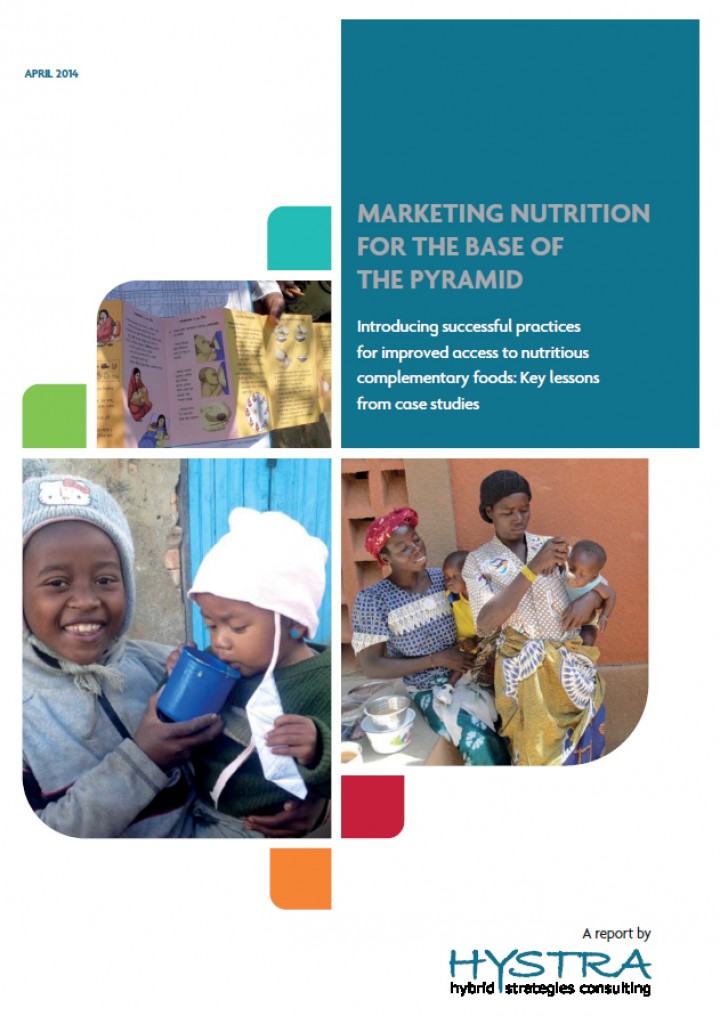Marketing Nutrition for the Base of the Pyramid - Introducing successful practices for improved access to nutritious complementary foods: Key lessons from case studies
Kayser, O., Klarsfeld, L., Brossard, S., Martin-Bouyer, N. (2014)

Published in: 2014
Pages: 87
Publisher:
Hystra hybrid strategies consulting
Author:
Kayser, O., Klarsfeld, L., Brossard, S., Martin-Bouyer, N.
Uploaded by:
SuSanA Admin
Partner profile:
common upload
4427 Views
19 Downloads
A range of solutions has been developed to improve the quality of nutrition during the critical first 1,000 days of life. Little is known however about the potential contribution of market-based solutions. This report learns from the successes and failures of best practice organizations that successfully sell nutritious complementary foods and supplements for 6-24 month old infants to BoP families in developing countries.
Content - Summary
Readers should keep in mind that this report : (1) does not entail an endorsement of the nutritional value of the products presented, (2) is based on a limited set of examples and might have overlooked important nuances in both products and geographies, and (3) will probably need to be revised as the evidence base builds up. With these caveats, the report proposes eight lessons drawn from the analysis of the innovative marketing, sales and distribution approaches of these successful organizations:
1) Marketing nutrition is not (only) about health: the value proposition should provide an immediate satisfaction to the child and convenience for the mother, while meeting local food habits
2) BoP consumers are ready to pay more for nutritious products that they value: mothers want to give their children the most expensive – seen as the best – food they can afford, not the cheapest product on the market
3) Effective promotion leverages trust and aspirations: this might include promotion or sampling through health professionals (when in line with local laws), aligning the entire caretaker environment to motivate behavior change, and using aspirational (rather than health) messages
4) Constant reminders and incentives drive compliance, which is key to simultaneously achieve social objectives and economic sustainability for the marketers of these products
5) When traditional retail exists, in rural and mature markets, it is the most cost efficient distribution channel: beyond marketing practices, daily product availability is necessary for regular use and must be achieved at the lowest possible costs
6) Door-to-door sales can create demand and build client loyalty in new urban markets, or in existing markets where consumers demand services which can only be provided by door-to-door
7) Optimizing salesforce productivity requires following private sector best practices for other types of fast moving consumer goods, and innovating “frugally” for distribution solutions
8) Broadening the customer base is key to building a sustainable business, i.e., by creating additional premium products, catering to a larger population than infants and young children, or carefully leveraging large-scale institutional orders.
Bibliographic information
Kayser, O., Klarsfeld, L., Brossard, S., Martin-Bouyer, N. (2014). Marketing Nutrition for the Base of the Pyramid - Introducing successful practices for improved access to nutritious complementary foods: Key lessons from case studies. Hystra hybrid strategies consulting
Filter tags
English















